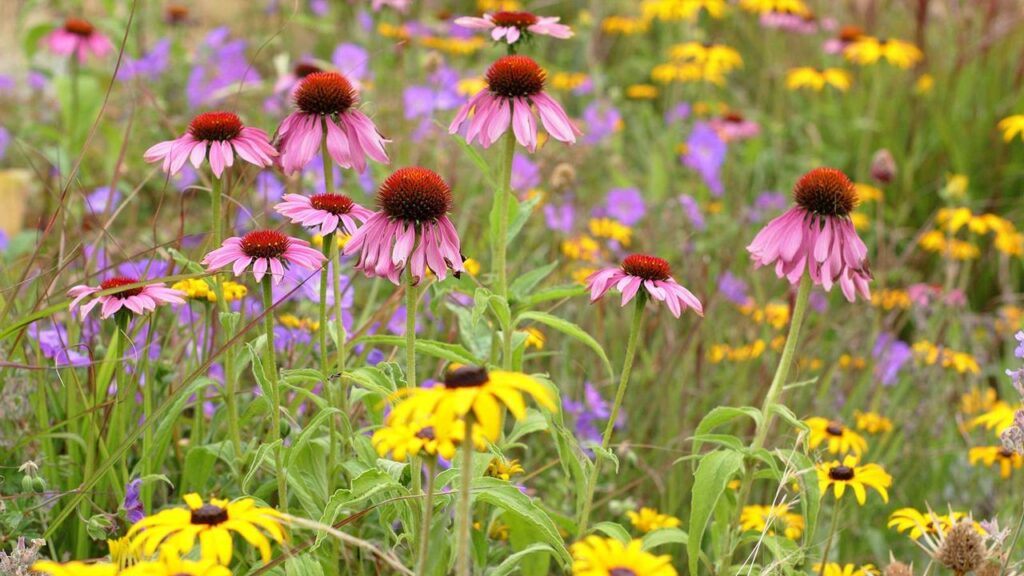
3CG5FXD Gavel garden planting with yellow Rudbeckia fulgida var. deamii, pink Echinacea Magnus, mauve Geranium Gerwat and Stipa tenuissima feathergrass
UPDATE: Landscape experts are urging homeowners to transform their gardens in 2026 by incorporating pollinator strips, crucial for supporting local ecosystems. This initiative comes as sustainable gardening practices gain traction, promising not only aesthetic appeal but also vital benefits for wildlife.
New reports confirm that backyards can be much more than mere patios and flower beds. As interest in wildlife-friendly gardening surges, homeowners are encouraged to prepare their spaces now for impactful changes in the spring. Pollinator strips—designated areas filled with native plants to attract bees, butterflies, and other essential pollinators—are emerging as a top priority.
Megan Bryant, lead horticulturist and landscape designer at Collington, explains, “These strips can enhance biodiversity and beautify your yard.” Initially favored in agricultural settings to boost crop yields, pollinator strips are now gaining popularity in suburban areas, including the often-overlooked “devil’s strips”—the small patches of land between sidewalks and roadways.
According to Bryant, these tiny zones, frequently neglected and exposed to harsh conditions, can be transformed into vibrant habitats. “Many gardeners are enchanted by the abundance of pollinators they attract,” she adds. With their low-maintenance nature and year-round visual interest, pollinator strips are more than just practical; they are a statement of commitment to environmental stewardship.
Landscape architects Catherine Trudeau and Paul Blanding from The Outside Design Studio in Chicago emphasize the importance of intentional design. “When done well, these strips can create a cohesive look that integrates seamlessly with the rest of the garden,” they state. Their expertise underscores the emotional connection many feel with nature, as these gardens can serve as personal sanctuaries.
Designing Your Pollinator Strip
Pollinator strips can vary in size and shape, allowing flexibility based on individual yard layouts. Bryant suggests starting with native plants like goldenrod, wild bergamot, and clustered mountain mint. “In the Midwest, consider echinacea, ajuga, and rudbeckia to create a colorful display that supports local wildlife,” she recommends.
For those with larger spaces, bulk seed collections that cover up to 1,000 square feet are available, featuring 18 different wildflower species. Pollinator strips are particularly advantageous for busy gardeners, requiring minimal upkeep once established. “They thrive in dry, compacted soil and primarily need weed control,” Bryant assures.
Experts advise leaving seed heads intact over winter to provide food for birds and enhance the garden’s architectural appeal. “These strips can fit into any garden, whether it’s a large field or a small front yard,” Bryant explains.
Next Steps for Homeowners
As 2026 approaches, it’s vital for homeowners to assess their gardens and consider where a pollinator strip might best fit. “If birdwatching is your goal, plant a strip where you can easily observe the activity,” suggests Bryant. Additionally, ensure optimal conditions with plenty of sunlight and well-draining soil for the best results.
While pollinator strips are a significant trend for 2026, they are part of a larger movement to support biodiversity in gardens. Homeowners can also implement bee watering stations and select plant colors that attract pollinators, extending their commitment to ecosystem health.
FINAL THOUGHT: The call for action is clear: as gardeners plan for 2026, integrating pollinator strips into their designs is not just a trend—it’s a necessary step toward fostering a healthier environment. Share this urgent news and inspire others to make their gardens a haven for pollinators today!






